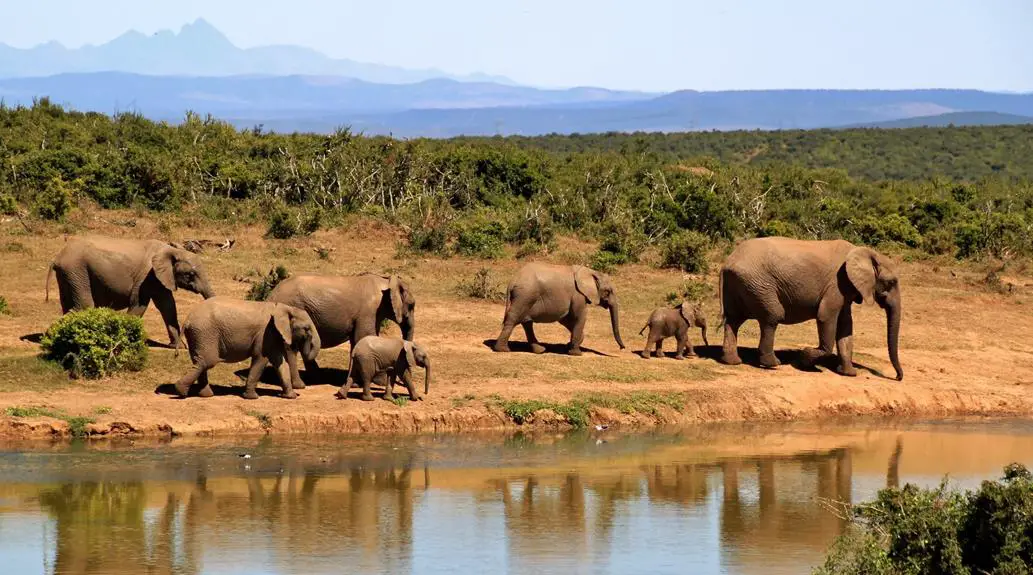Imagine stepping into a world where giants roam, their presence commanding your attention like a symphony of awe-inspiring might. In this realm, you encounter the majestic elephants, creatures so special that their very existence captivates the mind.
Explore their size and strength, their complex social structure, their remarkable memory and intelligence, their gentle and empathetic nature, and the cultural significance that has sparked conservation efforts.
Prepare to embark on a journey of understanding and appreciation for these extraordinary beings.
Key Takeaways
- Elephants are the largest land animals on Earth, with males reaching heights of up to 13 feet at the shoulder and weighing up to 14,000 pounds.
- Elephants possess impressive memory capacity, allowing them to remember complex routes, locate water sources, and display remarkable problem-solving abilities.
- Elephants have a complex social structure with hierarchy dynamics, led by the matriarch, and communication through vocalizations and physical touch strengthens social bonds.
- Elephants demonstrate emotional intelligence and empathy, comforting and consoling each other, helping injured herd members, and engaging in mourning rituals.
Size and Strength
You can’t help but be amazed by the size and strength of elephants. These powerful mammals possess unique adaptations that contribute to their incredible physical abilities.
Elephants are the largest land animals on Earth, with males reaching heights of up to 13 feet at the shoulder and weighing as much as 14,000 pounds. Their massive size is supported by a robust skeletal structure, including thick, weight-bearing bones and strong muscles.
The adaptations of their limbs enable them to carry such immense weight. Their legs are long and pillar-like, providing stability and distributing the load evenly. Elephants also have specialized feet with thick, cushion-like pads that absorb the impact when they walk.
Additionally, they possess a unique adaptation known as the ‘pillar-like limb’ which allows them to support their enormous size without collapsing under their own weight.
These remarkable physical adaptations contribute to the elephants’ ability to navigate their environment and perform impressive feats of strength such as uprooting trees and pushing heavy objects. However, their size and strength aren’t just for show. They serve important purposes in the elephants’ lives, including defense against predators and dominance displays within their complex social structure.
Transitioning into the subsequent section about the complex social structure, it’s fascinating to explore how elephants use their size and strength to establish hierarchical relationships and maintain social order within their herds.
Complex Social Structure
It’s intriguing how elephants rely on their size and strength to establish and maintain social order within their herds through both dominance displays and cooperative behaviors. Elephants live in a complex social structure with hierarchy dynamics and a matriarchal society. The matriarch, typically the oldest and largest female in the group, leads the herd and makes important decisions regarding food sources, water locations, and the overall movement of the group.
To better understand the social dynamics of elephants, let’s take a look at the following table:
| Social Order | Dominant Elephant | Subordinate Elephants |
|---|---|---|
| Matriarch | Female A | Females B, C, D |
| Adult Males | Male A | Males B, C |
| Juveniles | None | None |
| Calves | None | None |
In this hierarchy, the dominant elephant holds the highest rank and has authority over the subordinate elephants. The matriarch plays a crucial role in maintaining order and resolving conflicts within the herd. Cooperative behaviors, such as communication through vocalizations and physical touch, further strengthen the social bonds among individuals.
Understanding the hierarchy dynamics and the importance of the matriarchal society allows us to appreciate the complexity of elephant social structure. It highlights the significance of size and strength in establishing and maintaining social order, ensuring the survival and well-being of the herd as a whole.
Remarkable Memory and Intelligence
The remarkable memory and intelligence of elephants allow them to navigate long distances and remember important landmarks. Elephants possess an impressive memory capacity that enables them to remember complex routes and find their way in vast territories. This ability is crucial for their survival, as it allows them to locate water sources and food in their ever-changing environment. Additionally, elephants have been observed to display remarkable problem-solving abilities. They can use tools, such as branches or rocks, to reach food or defend themselves from predators. This demonstrates their cognitive flexibility and adaptability.
Furthermore, elephants exhibit emotional intelligence, which is a rare trait in the animal kingdom. They display empathy towards other members of their herd, showing concern and providing comfort in times of distress. They also exhibit a strong sense of social bonding, forming deep connections with family members and maintaining long-lasting relationships. This emotional intelligence is thought to be a result of their highly developed brain structure, particularly in the areas associated with emotions and memory.
Gentle and Empathetic Nature
When observing elephants in their natural habitat, it becomes evident that their gentle and empathetic nature is a result of their highly developed brain structure and social interactions. These gentle giants possess a remarkable emotional intelligence, which allows them to form deep bonds and exhibit behaviors that reflect their capacity for empathy. Here are three examples of their emotional intelligence:
- Compassion: Elephants have been observed comforting and consoling each other in times of distress. They’ll often touch each other gently with their trunks and emit low rumbling sounds to provide solace.
- Altruism: Elephants demonstrate selflessness by helping injured or stuck members of their herd. They use their strength to lift and support the struggling individual, showing a remarkable sense of empathy and care.
- Mourning: Elephants mourn the loss of their loved ones. They’ll gather around the deceased, touching and caressing the body with their trunks. They may even stay with the body for days, engaging in a mourning ritual that highlights their emotional depth.
The gentle giants’ emotional intelligence not only enhances their social interactions but also contributes to their cultural significance and the conservation efforts aimed at protecting them. Transitioning into the next section, it’s crucial to understand the importance of preserving these magnificent creatures and the impact they’ve on their ecosystem.
Cultural Significance and Conservation Efforts
You should consider the cultural significance of elephants and the conservation efforts that are being made to protect them. Elephants hold a special place in many cultural traditions around the world. They’ve been revered as symbols of wisdom, strength, and good luck. In many countries, elephants are an integral part of religious ceremonies, festivals, and rituals. Unfortunately, their populations are under threat due to various factors, including habitat loss and the illegal ivory trade.
Conservation efforts are crucial to ensure the survival of these magnificent creatures. Many organizations and governments are working tirelessly to protect elephant habitats, establish protected areas, and enforce laws against poaching and the ivory trade. These efforts involve a combination of scientific research, community engagement, and international collaboration.
One key area of focus is the ivory trade. The demand for ivory products continues to fuel the illegal poaching of elephants. Conservationists are working to raise awareness about the devastating consequences of the ivory trade and to promote alternative materials and sustainable practices.
Frequently Asked Questions
Do Elephants Have Any Natural Predators in the Wild?
Do elephants have any natural predators in the wild? Yes, they do. Lions, tigers, and crocodiles are known to prey on them. However, elephants have developed effective communication methods to warn each other and protect themselves from these predators.
How Do Elephants Communicate With Each Other?
Elephants communicate with each other through a combination of vocalizations and body language. They use trumpeting, rumbling, and roaring sounds, as well as various physical gestures like ear flapping and trunk movements, to convey messages to their herd members.
Can Elephants Recognize Themselves in a Mirror?
Elephants can recognize themselves in a mirror, displaying a level of self-awareness. This is a sign of high intelligence in animals. It shows that elephants have a unique cognitive ability, setting them apart from other species.
What Are Some Unique Behaviors That Elephants Exhibit Within Their Social Groups?
In the unique social interactions of elephants, they display remarkable cooperation dynamics within their groups. This behavior showcases their exceptional intelligence and ability to work together towards common goals.
How Do Conservation Efforts Impact the Local Communities Living Near Elephant Habitats?
Conservation efforts around elephant habitats pose challenges and provide economic benefits for local communities. These communities must navigate the delicate balance between protecting elephants and sustaining their own livelihoods.
Do Elephants’ Special Traits Include the Ability to Experience Emotions?
Do elephants’ special traits include the ability to experience emotions? There is a growing body of evidence pointing towards elephants’ emotional intelligence. These magnificent creatures have displayed behaviors such as grieving, forming deep bonds, and even showing empathy towards other elephants and even humans. Studies suggest that elephants possess a remarkable capacity to experience complex emotions, making them truly extraordinary beings.
Conclusion
In conclusion, elephants are truly remarkable creatures. Their size and strength, complex social structure, remarkable memory and intelligence, gentle and empathetic nature, as well as their cultural significance and conservation efforts, make them special in many ways.
Their majestic presence and unique characteristics have captivated the scientific community and the general public alike. As we continue to study and protect these magnificent animals, we uncover more of their secrets, and our understanding of their importance only grows.
The world would be a much poorer place without these magnificent beings.











